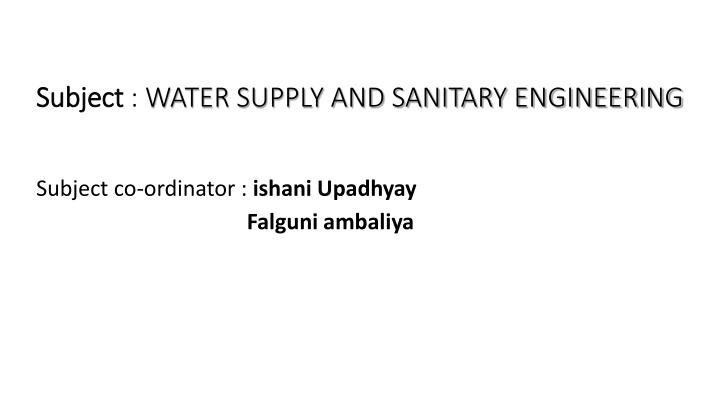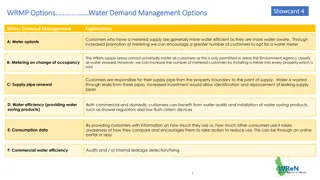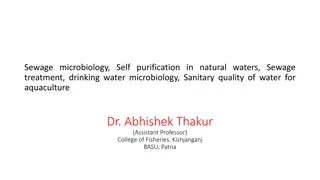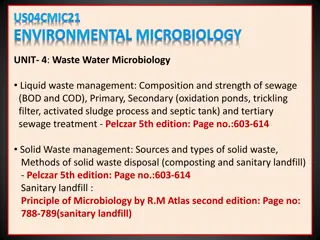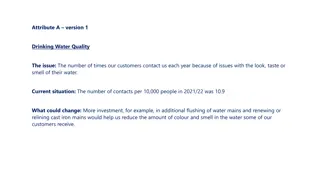Subject Subject : WATER SUPPLY AND SANITARY ENGINEERING
Sewage consists of various residential, public, and industrial wastewater with organic materials and microorganisms. Understanding its physical, chemical, and biological characteristics is essential for efficient treatment system design.
Download Presentation

Please find below an Image/Link to download the presentation.
The content on the website is provided AS IS for your information and personal use only. It may not be sold, licensed, or shared on other websites without obtaining consent from the author.If you encounter any issues during the download, it is possible that the publisher has removed the file from their server.
You are allowed to download the files provided on this website for personal or commercial use, subject to the condition that they are used lawfully. All files are the property of their respective owners.
The content on the website is provided AS IS for your information and personal use only. It may not be sold, licensed, or shared on other websites without obtaining consent from the author.
E N D
Presentation Transcript
Subject Subject : WATER SUPPLY AND SANITARY ENGINEERING Subject co-ordinator : ishani Upadhyay Falguni ambaliya
CHARACTERISTICS OF SEWAGE CHARACTERISTICS OF SEWAGE Presenting by: Divya kalal (186140306045) Krisha gajjar (186140306052 Priya ladva (186140306053) Avantika makwana (186140306056) Tiya mavdiya (186140306058)
INTRODUCTION Sewage consists of various residential, public and industrial mixture of wastewater, which contain organic materials in dissolved or suspended or colloidal form as well as various microorganisms useful and harmful to human life. We need the characteristics and examination of sewage before designing any sewage treatment system to work efficiently.
Characteristics Of Sewage The characteristics of sewage are classified as follows: 1. Physical characteristics 2. Chemical characteristics and 3. Biological characteristics
Physical characteristics Physical characteristics 1. Colour 2. Odour 3. Temperature 4. Turbidity 5. Specific gravity
Colour : colour is due to the suspended and other matters found in wastewater. if the colour is yellowish, grey or light brown, it is indicates fresh sewage. However if the colour is black or dark brown, it indicates stale and septic sewage. The colour of industrial sewage depends upon the chemical process used in the industries.
Odour : Normal fresh sewage has a musty odour which is normally not offensive, but as it starts to get stale, it begins to give offensive odour due to H2S, CH4 . Within 3 to 4 hours, all the oxygen present in the sewage gets exhausted and It starts emitting offensive odours, especially that of hydrogen sulphide gas, which is formed due to decomposition of sewage.
Temperature: The temperature has an effect on the biological activity of bacteria present in sewage, and it also affects the solubility of gases in sewage. In addition, temperature also affects the viscosity of sewage, which in turn affects the sedimentation process in its treatment. Average temperature of wastewater in India is about 20`C, which is quite close to the ideal temperature for the biological activities.
Turbidity: The turbidity of waste water is due to the suspension of fine particles. The turbidity depends upon the strength of sewage or waste water. The turbidity increases as sewage becomes stronger. Turbidity is measured by turbidity rod or Jackson s turbidimeter.
Specific gravity : The specific gravity of sewage is slightly more than that of water Due to suspended solids in wastewater, wastewater will have A higher turbidity, or cloudiness
Chemical characteristics Chemical characteristics 1. solids Solids present in sewage may be in any of these forms: Suspended solids : suspended solids are those solids which remain floating in sewage. Dissolved solids : Dissolved solids are those which remain dissolved in sewage just as salt in water.
Colloidal solids: Colloidal solids are finely divided solids remaining either in solution or in suspension. Settleable solids: Settleable solids are that portion of solids matter which settles out if sewage is allowed to remain undisturbed for period of 2 hours.
Further, the solids in sewage comprise of both: Further, the solids in sewage comprise of both: Organic solids(45%) It include, carbohydrates such as cellulose, cotton, fibre. fats and oils received from kitchens, laundries, shops, etc. nitrogenous compounds like proteins. Inorganic solids(55%) it include sand, gravel, grit, debris, chlorides etc.
2.pH value 2.pH value The pH value of sewage indicates the negative logarithm of hydrogen ion concentration in sewage. It is a measure of degree of acidity or alkalinity of sewage. It is measured on ph scale, which varies from 0 to 14 . If ph = 7, sewage is neutral If ph = 0 to 7, sewage is acidic If ph is 7 to 14, sewage is alkaline Fresh sewage is generally alkaline in nature. However as the time passes, its ph value tends to fall due to production of acids by bacterial action, and the sewage tends to become acidic.
3.chloride 3.chloride chlorides are generally found present in municipal sewage, and are derived from the kitchen wastes, human feces and urinary discharges, etc. The normal chloride content of domestic sewage is 120 mg/l, whereas the permissible chloride content for water supplies is 250 mg/l. The chloride content of waste water can be measured by titrating the sample of wastewater with standard silver nitrate solution, using potassium chromate as indicator.
4.Nitrogen contents 4.Nitrogen contents The presence of nitrogen in sewage indicates the presence of organic matter. In sewage nitrogen is found in variety of form like organic nitrogen, ammonia, nitrite, nitrate etc. Fresh sewage mainly contains organic nitrogen and very little inorganic form of nitrogen. In sewage treatment plant, NH3 and NO2 are finally converted to NO3.
5.Presence of fats, greases and oils 5.Presence of fats, greases and oils They are derived in sewage from the discharge of animals and vegetable matter, or from the garages, kitchens of hotels and restaurants etc. Such matter from scum on top of the sedimentation tanks, clogs the void of filter media and affects the diffusion of oxygen,thus interfering with the normal treatment methods. For estimating their amount, asample of sewage is evaporated, the residue solids left is mixes with ether and poured off, and again evaporated leaving behind oils and fats as residue, which can be weighed.
6. SULPHIDES, SULPHATES AND H 6. SULPHIDES, SULPHATES AND H2 2S GAS S GAS They are formed due to the decomposition of various Sulphur containing substances in sewage. In aerobic digestion of sewage, the aerobic and facultative bacteria oxidizes Sulphur & its compounds to initially form sulphides, which ultimately breakdown to sulphates. In anaerobic digestion, the anaerobic and facultative bacteria reduce the Sulphur and its compounds to sulphides, with evolution of h2s along with methane, carbon dioxide.
7. Toxic compounds 7. Toxic compounds Copper, lead, silver, chromium, arsenic, and boron are some of the cations which are toxic to microorganisms resulting in the malfunctioning of the biological treatment plants. These toxic compounds are derived from industrial wastewaters.
8. Dissolved oxygen (D.O.) 8. Dissolved oxygen (D.O.) Dissolved oxygen is the amount of oxygen in the dissolved state in sewage. Living organisms require dissolved oxygen in sewage to perform their metabolic process. The actual quantity of DO is governed by: i. Solubility of oxygen ii. Temperature iii. Purity of water iv. It decreases as temperature increases It is also determined by winklers method
9.Biochemical oxygen demand (BOD) 9.Biochemical oxygen demand (BOD) It is defined as the amount of oxygen requires by the microorganism to carry out decomposition of biodegradable organic matter under aerobic conditions. The BOD test is widely used to determine the pollution strength of domestic and industrial wastes in terms of the oxygen that they will require if discharged into natural watercourses.
It is the one of the most important test in stream pollution control activities. This test is of prime importance in regulatory work and in studies designed to evaluate the purification capacity of receiving bodies of water It is also useful in design of wastewater treatment plant and also to measure the efficiency of some treatment processes.
BOD test BOD test Dilution method is commonly used to carry out the BOD test. Procedure The dissolved oxygen in clear water is first found out and noted. The sample of sewage is diluted by this water and the dilution ratio is noted. Generally the dilution ratio is 100:1. The diluted sewage is then kept in an airtight glass bottle for 5 days at 20c for incubation. After this period, the amount of dissolved oxygen remaining in the glass bottle is worked out.
Then the loss of oxygen is determined which is the difference between the dissolved oxygen at the beginning and dissolved oxygen remaining at the end. The BOD is then calculated by the following relation: BOD5 = [ oxygen consumed *dilution ratio] in ppm If 1 ml of sewage is diluted to make 100 ml of test sample, the dilution factor or dilution ratio is 100/1 =100 BOD5 = OXYGEN CONSUMED * 100PPM
But, in actual experimentation in the laboratory, we generally use 300 ml sized BOD test bottles. If 5 ml of sewage is placed in the bottle and mixed with specially prepared dilution water to make 300 ml diluted sample. In this case. dilution ratio = 300/5 = 60 BOD5 = oxygen consumed * dilution ration =oxygen consumed *60ppm
Limitation of BOD test Limitation of BOD test 1. It is not prefer for industrial sewage. 2. Time duration of the test is 5 days. 3. Pre-treatment is needed if the sample contain toxic waste. 4. It is essential to have high concentration of active bacteria.
Chemical oxygen demand (COD) The amount of oxygen required for the chemical decomposition of organic matters in the sewage by strong oxidising agent under acidic condition is known as chemical oxygen demand. It can be used to measure both biodegradable and non biodegradable organic matter.
COD test COD test The COD test is carried out by the following procedure: i. A known amount of sample of sewage is taken in a pot ii. A known amount of potassium dichromate and sulphuric acid are added to the sample. iii. The mixture is kept for about 3 hours iv. During this period, chemical reaction takes place to produce co2 and h2o. v. After the reaction the remaining amount of potassium dichromate is determined by titration with ferrous ammonia sulphate Fe(NH4)2 (SO4)2 solution. vi. The consumption of potassium dichromate indicates the amount of oxygen required for the oxidation of organic matters.
Significance and application of COD test : 1. present in industrial wastes having toxic compounds likely to interfere with the biological life. 2. The COD test is widely used in place of BOD test in the operation of treatment facilities because, result can be obtained in 3 hours only. 3. It determines the strength of waste water which can not be determined by BOD test. 4. COD test is used to identify the performance of the various steps of treatment plant. The COD test can be carried out to measure organic matter
COD/BOD5 RATIO : As mentioned earlier, the COD value is always higher than BOD value, and therefore the COD/BOD5 ratio is always greater than 1. For typical untreated domestic sewage, the ratio COD/ BOD5 is found to vary from 1.25 to 2.5. If it is greater than 3, the sewage is considered difficult to biodegrade, and for non biodegradable sewage, it exceeds 10.
1. 1. 2. 3 . The COD test gives the total 3. The BOD test gives the amount of biologically active organic matter in the sewage. of biologically inactive organic matter in the sewage. 4. The test is not useful in the control of treatment process. 4 . The test is useful in the control of treatment process. 5. BOD test in necessary for domestic sewage only. 5 . COD test is necessary for the industrial sewage. 6. It does not determine the strength of sewage. 6 . It determines the strength of sewage. 7. In BOD, huge quantity of clear water is required to perform the oxidation of organic matters. be achieved by controlling the amount of chemical oxidizing agents. 7 . COD can 8. BOD value is always smaller than COD Value 8 . COD value is always greater than BOD value.
DISTINGUISHED BETWEEN BOD AND COD : DISTINGUISHED BETWEEN BOD AND COD : BOD COD 1. The BOD may be defined as the oxygen required for the micro- organisms to carry out biological decomposition of organic matter in the sewage under aerobic conditions and standard temperature. 1. The COD may be defined as the oxygen required for the chemical decomposition of organic matter in the sewage by strong oxidizing agent under acidic condition. 2. The BOD test takes a minimum of 5 days time 2. The COD test takes only 3 hours time.
BIOLOGICAL CHARACTERISTIC OF SEWAGE BIOLOGICAL CHARACTERISTIC OF SEWAGE The biological characteristic of sewage are related to the presence of following bacteria and microorganisms : 1. Bacteria: Aerobic bacteria Anaerobic bacteria Facultative bacteria Pathogenic bacteria Non pathogenic bacteria
2.Microorganisms 2.Microorganisms The microorganisms like algae, fungi and protozoa help the process of decomposition of sewage by photosynthesis or by breaking the organic compounds. Microorganisms can be either plants or animals. When the assemblages of aquatic organisms drift more or less passively with waves and current, they constitute the plankton. If, however, they change their position or location due to their own effort, they are called nekton.
The biological tests are carried out to know the presence of bacteria, fungi, algae, protozoa, etc. In the sewage. The presence of some bacteria indicates the degree of pollution in sewage. So, necessary measures should be taken to kill the pathogenic bacteria. The presence of fungi, algae and protozoa is necessary for the treatment of sewage. The biological tests are carried out by microscope and by studying the biological character of the bacteria.
Thank you Thank you
